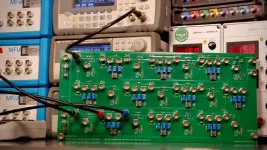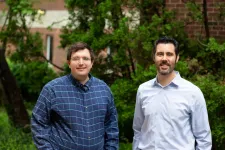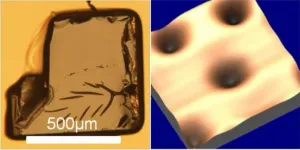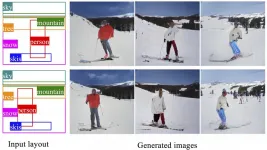Researchers discover how cells can survive in high salt concentrations
2021-06-01
(Press-News.org) Cells have to constantly adapt to their surroundings in order to survive. A sudden increase in the environmental levels of an osmolyte, such as salt, causes cells to lose water and shrink. In a matter of seconds, they activate a mechanism that allows them to recover their initial water volume and avoid dying.
Finding out which genes are involved in surviving osmotic stress was the subject of a study led by the laboratories of Dr. Posas and Dr. de Nadal at the Institute for Research in Biomedicine (IRB Barcelona) and Dr. Valverde at Pompeu Fabra University (UPF), in collaboration with a group led by Dr. Moffat from the University of Toronto (Canada). wide-genome genetic screening, the scientists discovered the central role of a gene known as LRRC8A in cellular ability to survive osmotic shock.
This gene codes for a protein that forms channels in the membrane and that allow chloride ions to leave the cell. "Using a human epithelial cell model, as well as other human and mouse cell types, we have been able to demonstrate that this channel opens shortly after the cells are exposed to a high concentration of sodium chloride (NaCl)," explains Dr. De Nadal, who, together with Dr. Francesc Posas, heads the Cell Signalling laboratory at IRB Barcelona. The authors have also identified the molecular mechanism that causes this rapid opening. The chloride channel phosphorylates, which means a phosphate group is added to a specific amino acid in its sequence, thus activating the channel.
"This has been a very complex project, and it has taken us years to see the light," explains Dr. Miguel Ángel Valverde, head of UPF's Laboratory of Molecular Physiology. "We have also shown how vital it is for this channel to become activated and remove chloride in order to start the volume recovery process and for cells to survive over time," he adds.
The use of a violet dye that stains only living cells has allowed the researchers to observe that cell death increases by approximately 50% when the activity of this chloride channel is blocked with a particular compound.
A journey through time to answer old questions
In the '90s, various landmark scientific papers on cell volume regulation described the process by which cells regulate their volume to survive. It was known that the proteins responsible for volume recovery under salt stress require low intracellular concentrations in order to become activated, but it was not known how this occurred under such adverse conditions. With this discovery, the authors have answered a question posed by researchers years ago: how does chloride exit the cell to start the whole process? In the words of the paper's main co-author, Dr. Selma Serra (UPF): "Now we have the answer to that question. It is the LRRC8A channel that brings down the chloride levels in a cell. Until now we had a good understanding of the role played by this channel in cell adpatation to environments with very low salt concentrations. The big challenge was to find out how the same chloride channel could be crucial in the opposite mechanism. At the beginning of the project, it seemed to go against any kind of scientific logic that a channel used to shrink cells could also swell them."
Using electrophysiological and fluorescence microscopy techniques in living cells to ascertain intracellular chloride levels, the researchers have demonstrated the involvement of the LRRC8A chloride channel in responses to high-salt stimuli.
A major technical and conceptual challenge
Studying this process at the molecular level has posed a considerable challenge for the team involved in this project. Because it is very complicated to conduct in vivo studies of cells while they undergo osmotic shock and shrink. "Imagine you're looking at a juicy grape, and suddenly it looks like a raisin, that makes things very complicated for us," say the authors.
Another high-impact factor is that, under these stress conditions, the mechanism for activating the chloride channel is very different to what has been described so far in the literature. The article's lead co-author, Predrag Stojakovic, says, "It came as a big surprise to find out that the signalling pathways in response to stress, the MAP kinase, proteins we've been studying in the lab for months, are directly responsible for activating this channel". MAP kinases are a group of signalling proteins that add phosphate groups to other proteins, thus activating or deactivating them. Using molecular techniques, the authors have looked throughout the channel's protein to find the target sequence of these kinase proteins. "We have been able to identify the specific residue of the chloride channel that leads to activation under the control of the MAP kinase channel in response to stress," says doctoral student Stojakovic.
Future implications
"This new piece of research opens up new possibilities for studying cell adaptation and survival salt stress. Certain organs of the body, such as the kidneys, are often exposed to high salt concentration, which can threaten their survival. Knowing what molecules control survival under these conditions could be very useful for understanding certain pathologies that entail volume recovery in response to salts," explains Dr. Posas.
In addition, discovering the role of this channel in these cell regulation processes is highly relevant in many pathologies involving proteins regulated by LRRC8A. This may be significant in situations such as certain kinds of arterial hypertension or cerebral ischemia.
INFORMATION:
[Attachments] See images for this press release:
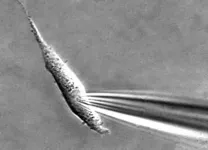
ELSE PRESS RELEASES FROM THIS DATE:
2021-06-01
In a joint effort, ct.qmat scientists from Dresden, Rostock, and Würzburg have accomplished non-Hermitian topological states of matter in topolectric circuits. The latter acronym refers to topological and electrical, giving a name to the realization of synthetic topological matter in electric circuit networks. The main motif of topological matter is its role in hosting particularly stable and robust features immune to local perturbations, which might be a pivotal ingredient for future quantum technologies. The current ct.qmat results promise a knowledge transfer from electric circuits to alternative optical platforms, and have just been published in Physical Review Letters.
Topological defect tuning in non-Hermitian systems
At the center of the currently reported work is the ...
2021-06-01
Hydrogen peroxide (H2O2) is used to disinfect minor cuts at home and for oxidative reactions in industrial manufacturing. Now, the pandemic has further fueled demand for this chemical and its antiseptic properties. While affordable at the grocery store, H2O2 is actually difficult and expensive to manufacture at scale.
A team led by the University of Illinois Urbana-Champaign has demonstrated a more efficient and environmentally friendly method to produce H2O2, according to a recent study published in the Journal of the American Chemical Society.
"While the two ingredients--hydrogen and oxygen--are either inexpensive or freely available from the atmosphere, hydrogen peroxide is highly reactive and unstable, which makes it very hard to produce," said first author Tomas ...
2021-06-01
TAMPA, Fla. - Moffitt Cancer Center, a national leader in cancer care and research and the only National Cancer Institute-designated Comprehensive Cancer Center based in Florida, is presenting new data from dozens of clinical research studies at this year's American Society of Clinical Oncology (ASCO) Annual Meeting, the world's largest clinical cancer research meeting. Moffitt investigators will lead 25 abstract presentations, five education sessions, two cancer-based panels and two clinical science symposia. The virtual meeting is June 4-8.
Highlights include:
Oral Presentations:
Dr. Bijal Shah will ...
2021-06-01
Physicists at the University of Bath in the UK, in collaboration with researchers from the USA, have uncovered a new mechanism for enabling magnetism and superconductivity to co-exist in the same material. Until now, scientists could only guess how this unusual coexistence might be possible. The discovery could lead to applications in green energy technologies and in the development of superconducting devices, such as next-generation computer hardware.
As a rule, superconductivity (the ability of a material to pass an electrical current with perfect efficiency) and magnetism (seen at work in fridge magnets) make poor bedfellows because the alignment of the tiny electronic magnetic particles in ferromagnets ...
2021-06-01
A catastrophic drop in atmospheric ozone levels around the tropics is likely to have contributed to a bottleneck in the human population around 60 to 100,000 years ago, an international research team has suggested. The ozone loss, triggered by the eruption of the Toba supervolcano located in present-day Indonesia, might solve an evolutionary puzzle that scientists have been debating for decades.
"Toba has long been posited as a cause of the bottleneck, but initial investigations into the climate variables of temperature and precipitation provided no concrete ...
2021-06-01
In interstellar dust clouds, turbulence must first dissipate before a star can form through gravity. A German-French research team has now discovered that the kinetic energy of the turbulence comes to rest in a space that is very small on cosmic scales, ranging from one to several light-years in extent. The group also arrived at new results in the mathematical method: Previously, the turbulent structure of the interstellar medium was described as self-similar - or fractal. The researchers found that it is not enough to describe the structure mathematically as a single fractal, a self-similar structure as known from the Mandelbrot set. Instead, they added several different fractals, so-called multifractals. The new methods can thus be used to resolve ...
2021-06-01
Researchers from North Carolina State University have developed a new state-of-the-art method for controlling how artificial intelligence (AI) systems create images. The work has applications for fields from autonomous robotics to AI training.
At issue is a type of AI task called conditional image generation, in which AI systems create images that meet a specific set of conditions. For example, a system could be trained to create original images of cats or dogs, depending on which animal the user requested. More recent techniques have built on this to incorporate conditions regarding an image layout. This allows users to specify which types of objects they want to appear in particular places on the screen. ...
2021-06-01
Amsterdam, June 1, 2021 - The Treatabolome project is a research initiative to develop a freely available, interoperable online platform dedicated to disseminating rare disease and gene-specific treatment information to healthcare professionals regardless of their level of specialized expertise. Developed under the Solve-RD European Research Project, it is intended to reduce treatment delays for patients with rare diseases by directly linking diagnosis and treatment information. This initiative is highly relevant to neuromuscular disorders as they are rare diseases by definition. In this special issue of the Journal of Neuromuscular Diseases, experts contribute Treatabolome-feeding systematic literature reviews on rare neurological ...
2021-06-01
Neutrons - Space ice, un-Earthly cold
Researchers from NASA's Jet Propulsion Laboratory and Oak Ridge National Laboratory successfully created amorphous ice, similar to ice in interstellar space and on icy worlds in our solar system. They documented that its disordered atomic behavior is unlike any ice on Earth.
The findings could help interpret data from future NASA missions such as Europa Clipper, which will assess the habitability of Jupiter's moon, Europa.
Using the Spallation Neutron Source's SNAP instrument, the scientists replicated the cold vacuum of space and added a few molecules ...
2021-06-01
Single atomic defect is the smallest structural unit of solid material. The construction of devices based on single defect can reach the limit of miniaturization of semiconductor devices. In the past decades, the creation and manipulation of single defects in semiconductors opened a new research field, and could be used to physically realize "qubits" of solid-state quantum computation through spin or electron charge. Most interest have focused on the studies of spin quantum computing. However, the spin manipulation need an optical and magnetic field. On the contrary, multiple ...
LAST 30 PRESS RELEASES:
[Press-News.org] Researchers discover how cells can survive in high salt concentrations

